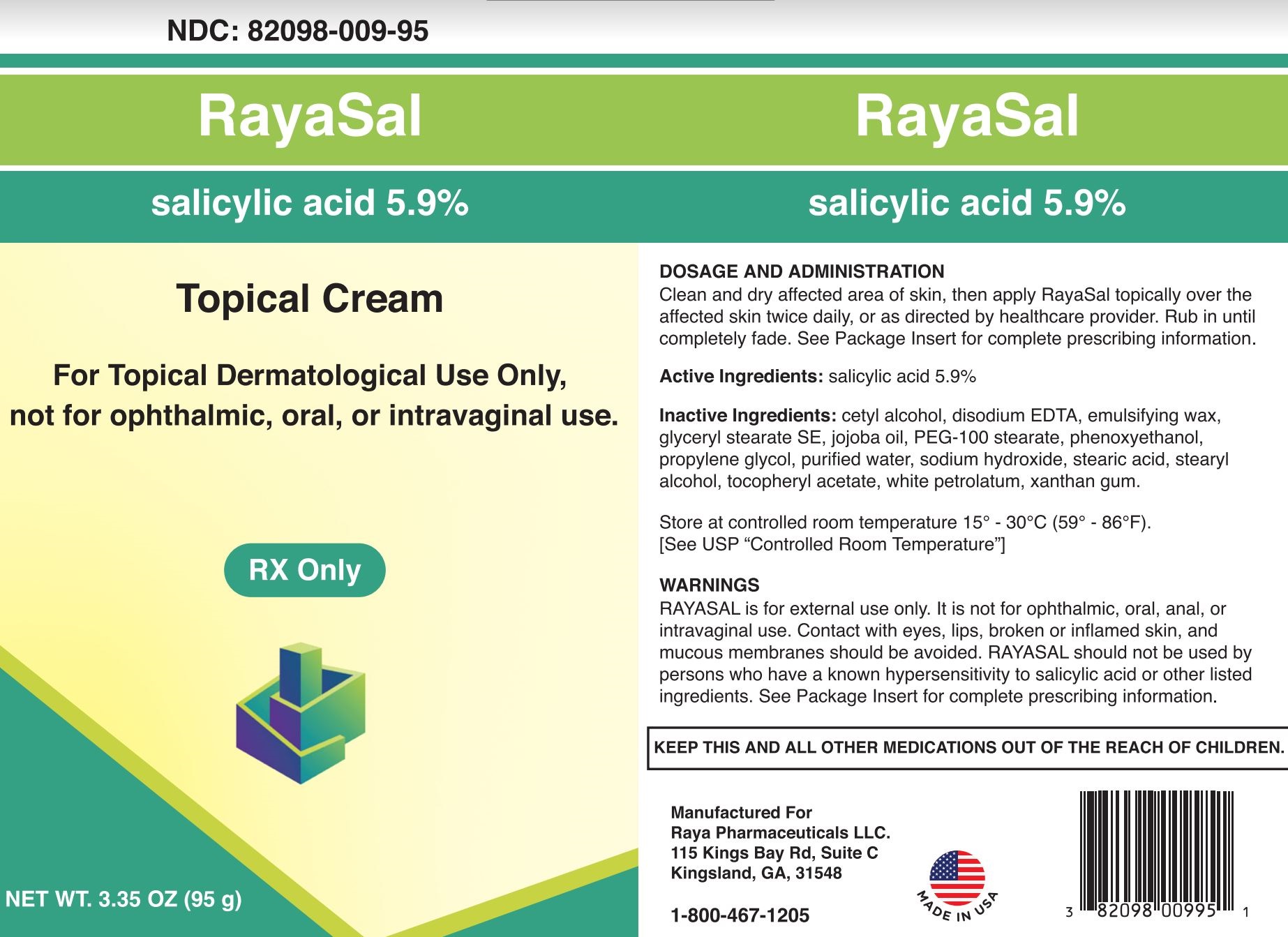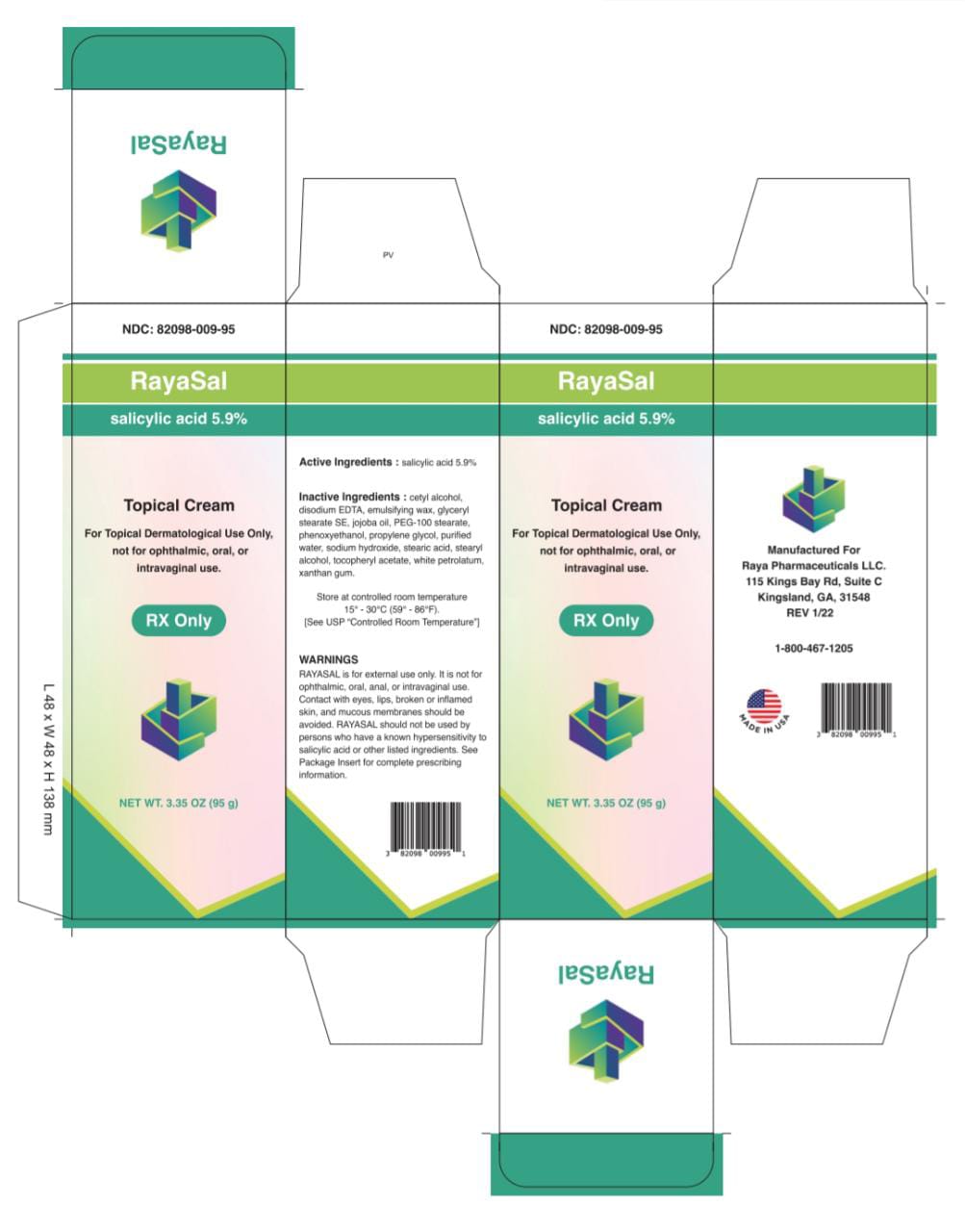Rayasal Cream Prescribing Information
Package insert / product label
Generic name: salicylic acid
Dosage form: cream
Medically reviewed by Drugs.com. Last updated on Jan 4, 2024.
On This Page
RayaSal
salicylic acid, 5.9% Cream
Rx Only
For Topical Dermatological Use Only, not for ophthalmic, oral, or intravaginal use.
RAYASAL is applied topically and used to remove excessive keratin in hyperkeratotic skin disorders. Each gram of RAYASAL contains salicylic acid 5.9% as the active ingredient and the following inactive ingredients: cetyl alcohol, disodium EDTA, emulsifying wax, glyceryl stearate SE, jojoba oil, PEG-100 stearate, phenoxyethanol, propylene glycol, purified water, sodium hydroxide, stearic acid, stearyl alcohol, tocopheryl acetate, white petrolatum, xanthan gum.
Salicylic acid has been shown to produce desquamation of the horny layer of skin while not affecting qualitative or quantitative changes in the structure of the viable epidermis 1,2. The mechanism of action has been attributed to the dissolution of intercellular cement substances 3. In a study of the percutaneous absorption of salicylic acid 6% in four patients with extensive active psoriasis, Taylor and Halprin 4showed that peak serum salicylate levels never exceeded 5 mg/100 ml even though more than 60% of the applied salicylic acid was absorbed. Systemic toxic reactions are usually associated with higher serum levels (30 to 40 mg/100 ml). Peak serum levels occurred within 5 hours of the topical application under occlusion. The sites were occluded for 10 hours over the entire body surface below the neck. Since salicylates are distributed in the extracellular space, patients with a contracted extracellular space due to dehydration or diuretics have higher salicylate levels than those with common extracellular space. (See PRECAUTIONS).
The primary metabolites identified in the urine after topical administration are salicyluric acid (52%), salicylate glucuronides (42%), and free salicylic acid (6%). The urinary metabolites after percutaneous absorption differ from those after oral salicylate administration; those derived from percutaneous absorption contain more glucuronides and less salicyluric and salicylic acid. Almost 95% of a single dose of salicylate is excreted within 24 hours of its entrance into the extracellular space. Fifty to eighty percent of salicylate is protein bound to albumin. Salicylates compete with the binding of several drugs and can modify the action of these drugs. By similar competitive mechanisms, other drugs can influence salicylate serum levels. (See PRECAUTIONS).
RAYASAL should not be used in any patient known to be sensitive to salicylic acid or any other listed ingredients.
For dermatologic Use
RAYASAL is a topical aid in the removal of excessive keratin in hyperkeratotic skin disorders, including verrucae and the various ichthyoses, keratosis palmaris and plantaris, keratosis pilaris, pityriasis rubra pilaris, and psoriasis.
For Podiatric Use
RAYASAL is a topical aid in removing excessive keratin on dorsal and plantar hyperkeratotic lesions.
RAYASAL is for external use only. It is not for ophthalmic, oral, anal, or intravaginal use. Contact with eyes, lips, broken or inflamed skin, and mucous membranes should be avoided. RAYASAL should not be used by persons who have a known hypersensitivity to salicylic acid or other listed ingredients. Prolonged use over large areas, especially in children and those patients with significant renal or hepatic impairment, could result in salicylism. Concomitant use of other drugs which may contribute to elevated serum salicylate levels should be avoided where the potential for toxicity is present. In children under 12 years of age and those patients with renal or hepatic impairment, the area to be treated should be limited, and the patient should be monitored closely for signs of salicylate toxicity: nausea, vomiting, dizziness, loss of hearing, tinnitus, lethargy, hyperpnoea, diarrhea, psychic disturbances.
In the event of salicylic acid toxicity, RAYASAL should be discontinued. Fluids should be administered to promote urinary excretion. Treatment with sodium bicarbonate (oral or intravenous) should be instituted as appropriate. Considering the potential risk of developing Reye's syndrome, salicylate products should not be administered to children or teenagers with varicella or influenza, unless directed by a physician.
RAYASAL should be used only as directed by a physician and should not be used to treat any condition other than that for which it is prescribed. RAYASAL should not be used on any skin area where inflammation or exudation is present as increased absorption may occur. If redness or irritation occurs, discontinue use and consult with prescribing physician.
The following interactions are from a published review 5and include reports concerning oral and topical salicylate administration. The relationship of these interactions to the use of SALICYLIC ACID is not known.
| A. Due to the competition of salicylate with other drugs for binding to serum albumin the following drug interactions may occur: | |
| Drug | Description of Interaction |
| Tolbutamide; Sulfonylureas | Hypoglycemia potentiated |
| Methotrexate | Decreases tubular reabsorption; clinical toxicity from methotrexate can result |
|
Oral Anticoagulants | Increased bleeding |
| B. Drugs changing salicylate levels by altering renal tubular reabsorption: | |
|
Drug |
Description of Interaction |
| Corticosteroids | Decreases plasma salicylate level; tapering doses of steroids may promote salicylism |
| Ammonium Sulfate | Increases plasma salicylate level |
| C. Drugs with complicated interactions with salicylates: | |
| Drug |
Description of Interaction |
| Heparin | Salicylate decreases platelet adhesiveness and interferes with hemostasis in heparin-treated patients |
| Pyrazinamide | Inhibits pyrazinamide-induced hyperuricemia |
| Uricosuric Agents | Effect of probenecid, sulfinpyrazone, and phenylbutazone inhibited |
|
D. The following alterations of laboratory tests have been reported during salicylate therapy:6 |
|
| Laboratory Tests | Effect of Salicylates |
| Thyroid Function | Decreased PBI; increased T uptake |
| Urinary Sugar | False negative with glucose oxidase; false positive with Clinitest with high-dose salicylate therapy (2-5g qd) |
| 5 Hydroxyindole Acetic Acid | False negative with fluorometric test |
| Acetone, Ketone Bodies | False positive FeCl in Gerhardt reaction; red color persists with boiling |
| 17-OH corticosteroids |
False reduced values with >4.8 g qd salicylate |
|
Vanilmandelic Acid |
False reduced values |
| Uric Acid |
May increase or decrease depending on the dose |
| Prothrombin | Decreased levels; slightly increased prothrombin time |
Pregnancy (Category C)
Salicylic acid is teratogenic in rats and monkeys. It is difficult to extrapolate from oral doses of acetylsalicylic acid used in these studies to topical administration as the oral dose to monkeys may represent four times the Maximum daily human dose of salicylic acid when applied topically over a large body surface. There are no adequate and well-controlled studies in pregnant women. RAYASAL should be used during pregnancy only if the potential benefit justifies the risk to the fetus.
Nursing Mothers
It is unknown whether topically applied salicylic acid is excreted in human milk. Since many drugs are excreted in human milk, caution should be exercised by physicians when administering RAYASAL to nursing mothers and nursing mothers should certainly not apply RAYASAL to the chest area or any other part of the body with which the nursing child's mouth is likely to come in contact. Because of the potential for serious adverse reactions in nursing infants from the mother's use of RAYASAL, a decision should be made whether to discontinue nursing or to discontinue the drug, taking into account the importance of the drug to the mother.
Carcinogenesis, Mutagenesis, Impairment of Fertility
No data are available concerning the potential carcinogenic or reproductive effects of RAYASAL. It has been shown to lack mutagenic potential in the Ames Salmonella test.
Transient stinging, burning, itching or irritation is possible. Peeling of the skin may increase as the salicylic acid works to loosen excess keratin. If excessive burning, stinging or peeling occurs, discontinue use and consult your physician.
Clean and dry affected area of skin, Then apply RayaSal topically over the affected skin twice daily, or as directed by healthcare provider. Rub in until completely fade.
The preferable method of use is to apply RAYASAL Cream thoroughly to the affected area and occlude the area at night. Preferably, the skin should be hydrated for at least five minutes prior to application. The medication is washed off in the morning, and if excessive drying and/or irritation is observed, a bland cream or lotion may be applied. Once the clearing is apparent, the occasional use of RAYASAL Cream will usually maintain the remission. In those areas where occlusion is difficult or impossible, the application may be made more frequently; hydration by wet packs or baths prior to application apparently enhances the effect. Unless hands are being treated, hands should be rinsed thoroughly after application.
RAYASAL Salicylic Acid 5.9% Gel is supplied in a 95-gram AIRLESS pump bearing the NDC Number 382098-009-95
Store at a controlled room temperature of 15° - 30°C (59° - 86°F). [See USP “Controlled Room Temperature”]
- Davies M, Marks R: Br J Dermatol 95: 187-192, 1976.
- Mars R, Davies M, Cattel A: J Invest Dermatol 64: 283, 1975.
- Huber C, Christophers E: Arch Derm Res 257: 293-297, 1977.
- Taylor JR, Halprin KM: Arch Dermatol 111: 740-743, 1975.
- Goldsmith LA: Int J Dermatol 18: 32-36.
- Wilson JG, Ritter EJ, Scott WJ, Fradlein R: Tox Appl Pharmacol 41: 67-78, 1977.
All prescription substitutions using this product shall be made subject to state and federal statutes as applicable. NOTE: This is not an Orange Book product and has not been subjected to FDA therapeutic equivalency or another equivalency testing. No representation is made as to the generic status or bioequivalency. Each person recommending a prescription substitution using this product shall make such recommendations based on each such person’s professional opinion and knowledge upon evaluating the active ingredients, excipients, inactive ingredients, and chemical formulation information provided herein.
| RAYASAL
salicylic acid 5.9% cream |
||||||||||||||||||||||||||||||||||
|
||||||||||||||||||||||||||||||||||
|
||||||||||||||||||||||||||||||||||
|
||||||||||||||||||||||||||||||||||
|
||||||||||||||||||||||||||||||||||
|
||||||||||||||||||||||||||||||||||
|
||||||||||||||||||||||||||||||||||
| Labeler - Raya Pharmaceuticals LLC (106631637) |
Frequently asked questions
More about Rayasal (salicylic acid topical)
Professional resources
Other brands
Keralyt Shampoo, KeralytGel, Salex, Salvax, ... +5 more


